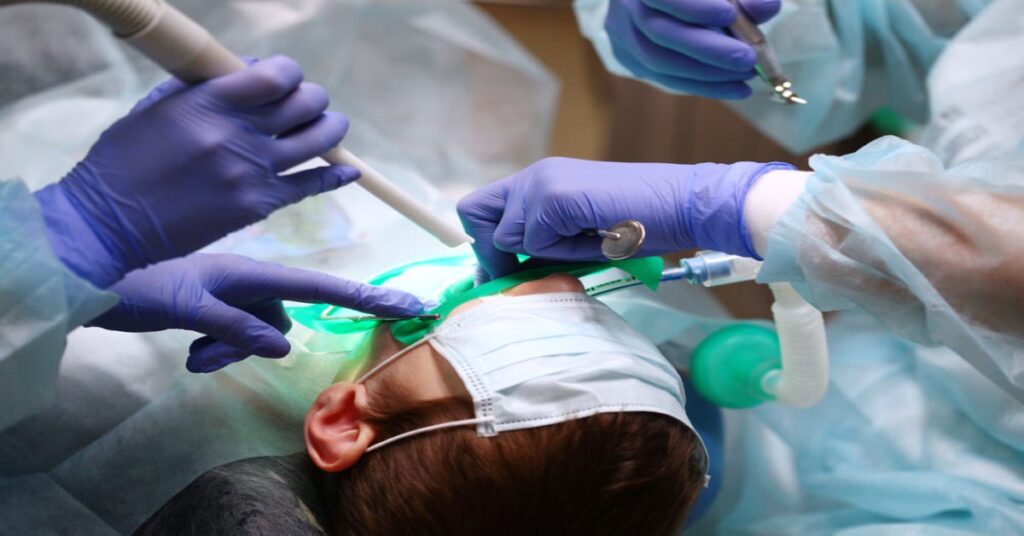Dental dams are a tool dentists use to perform their duties. The human mouth is filled with bacteria, not just a little. Up to 1,000 different types of bacteria may reside in your mouth right now. Even if you clean your teeth and mouth amazingly, bacteria will always be inside. Dental dams are a protective barrier against bacteria from entering open areas and causing a life-threatening infection.
Dental dams are thin square sheets made of latex or non-latex alternatives for patients with latex allergies. The dental dam is placed over the operative site and isolated from the rest of the mouth. Dental dams have a hole in the middle placed over the treatment area. This is typically done with a small dental clamp positioned around the tooth.
Here are the ins and outs of dental dams.
- When to use a dental dam
- Prevents dental materials ingestion
- How a dental dam is placed in the mouth
- All dentists do not use dental dams
- Why endodontists prefer dental dams
- Wearing a dental dam can feel strange
- Dental dams are safe and pose no risk
- Dental dams come in all sorts of colors
- If you have questions, simply ask
When to use a dental dam
A dentist typically recommends a dental dam for anyone undergoing orthodontic treatment that exposes at least one tooth’s interior. A dentist doesn’t want bacteria in there. A dental dam isolates an area being worked on, allowing a dentist to concentrate on the tooth or teeth. It can save against bacteria.
A dental dam is predominantly used in endodontic procedures, prosthodontics (such as crowns and bridges), veneer placements, and similar restorative dental treatments.
Prevents dental materials ingestion
Another significant function of a dental dam is to prevent a patient from ingesting or aspirating any materials or by-products of the procedure. A dental dam can retain materials and instruments, preventing uncomfortable accidents.
How a dental dam is placed in the mouth
Several instruments may be used to prepare and place the dental dam. The size of the teeth must be analyzed to determine the hole to be created in the material. The hole is manually drilled to accommodate the procedure.
The hole is then placed over the tooth, and a frame is used to stretch the dental dam over the mouth and lips. The frame adds tension and keeps the material edges from moving unnecessarily during the procedure.
All dentists do not use dental dams
Dental dam use depends entirely on the dentist. Many dentists use dental dams frequently, others employ them only for specific procedures, and a select few use them not at all. It depends on the dentist what they’re comfortable doing and whether they prioritize protecting themselves from an infection.
Even though not all dentists use dental dams, they are highly recommended by all major dental and endodontist organizations.
Why endodontists prefer dental dams
Most endodontists use dental dams because they often work with the soft tissue inside teeth, the pulp. Isolating the tooth with a dental dam is the safest way to maintain the highest standard of care during procedures.
A root canal, for example, is a common endodontist procedure where a dental dam is essential. As the infected tooth pulp is extracted, an endodontist does not want to risk inviting bacteria.
Wearing a dental dam can feel strange
Patients wearing a dental dam may not have worn one before or seen one, which can feel strange. That said, it’s not painful in the least. If you feel any discomfort while wearing a dental dam, it’s not discomfort that should last long.
Dental dams are safe and pose no risk
If wearing a dental dam is uncomfortable, remember it is safe and will not damage or harm you. If you are getting a root canal, crown, bridge, or veneer placement done, a dental dam should provide peace of mind that the procedure is being done correctly and that patient health is a priority.
Dental dams come in all sorts of colors
Dental dams can be brightly coloured or darker and come in any hue. It depends on the procedure and the practitioner’s preference for colour. Brightly coloured dental dams increase the light in the area. Dark dental dams, however, may make a tooth stand out better to some dentists and endodontists.
If you have questions, simply ask
Dentists are happy to explain anything you are unsure about or uncomfortable with. If a dental dam is a concern, don’t hesitate to mention it to your dentist and ask any questions that come to mind about it.
Related Articles:
